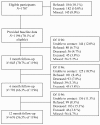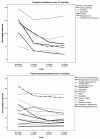Screening for distress, the 6th vital sign: common problems in cancer outpatients over one year in usual care: associations with marital status, sex, and age
- PMID: 23031647
- PMCID: PMC3528655
- DOI: 10.1186/1471-2407-12-441
Screening for distress, the 6th vital sign: common problems in cancer outpatients over one year in usual care: associations with marital status, sex, and age
Abstract
Background: Very few studies examine the longitudinal prevalence of problems and the awareness or use of clinical programs by patients who report these problems. Of the studies that examine age, gender and marital status as predictors of a range of patient outcomes, none examines the interactions between these demographic variables. This study examined the typical trajectory of common practical and psychosocial problems endorsed over 12 months in a usual-care sample of cancer outpatients. Specifically, we examined whether marital status, sex, age, and their interactions predicted these trajectories. We did not actively triage or refer patients in this study in order to examine the natural course of problem reports.
Methods: Patients completed baseline screening (N = 1196 of 1707 approached) and the sample included more men (N = 696) than women (N = 498), average age 61.1 years. The most common diagnoses were gastrointestinal (27.1%), prostate (19.2%), skin (11.1%) and gynecological (9.2%). Among other measures, patients completed a Common Problem Checklist and Psychosocial Resources Use questions at baseline, 3, 6, and 12 months using paper and pencil surveys.
Results: Results indicated that patients reported psychosocial problems more often than practical and both decreased significantly over time. Younger single patients reported more practical problems than those in committed relationships. Younger patients and women of all ages reported more psychosocial problems. Among a number of interesting interactions, for practical problems, single older patients improved more; whereas among married people, younger patients improved more. For psychosocial problems we found that older female patients improved more than younger females, but among males, it was younger patients who improved more. Young single men and women reported the most past-and future-use of services.
Conclusions: Younger women are particularly vulnerable to experiencing practical and psychosocial problems when diagnosed with cancer, but being married protects these younger women. Marriage appeared to buffer reports of both practical and psychosocial problems, and led to less awareness and use of services. Unexpectedly, young men reported the highest use of psychosocial services. This study informs clinical program development with information on these risk groups.
Figures




References
-
- Holland JC, Andersen B, Breitbart WS, Compas B, Dudley MM, Fleishman S, Fulcher CD, Greenberg DB, Greiner CB, Handzo GF, Hoofring L, Jacobsen PB, Knight SJ, Learson K, Levy MH, Loscalzo MJ, Manne S, McAllister-Black R, Riba MB, Roper K, Valentine AD, Wagner LI, Zevon MA. Distress Management. J Natl Compr Canc Netw. 2010;8(4):448–485. - PubMed
Publication types
MeSH terms
Grants and funding
LinkOut - more resources
Full Text Sources
Medical
Miscellaneous

